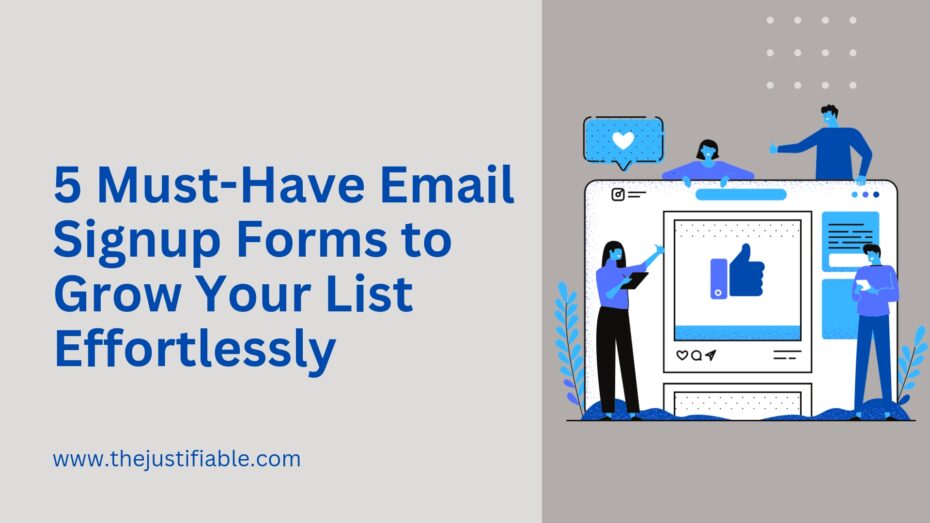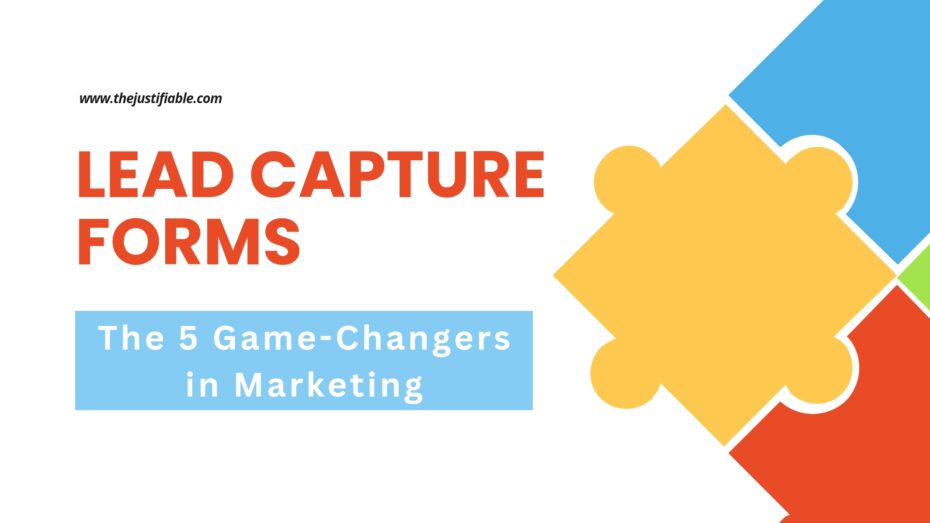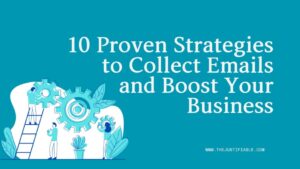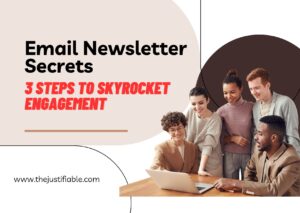Table of Contents
“Money is in the list,” as the old marketing adage goes, highlights the critical importance of email marketing in today’s digital ecosystem. Email signup forms stand at the forefront of this arena, serving as the pivotal bridge between businesses and their potential customers.
In the realm of e-commerce, where competition is fierce and attention spans are short, capturing the interest of your audience through compelling email signup forms can be the difference between success and stagnation. It’s not just about growing a list; it’s about nurturing a community eager to hear from you.
The effectiveness of a well-curated email list cannot be overstated. It propels your business forward by enabling direct communication with your audience, offering insights into their preferences, and allowing for personalized marketing strategies that drive engagement and conversions. By integrating email signup forms seamlessly across your e-commerce platform, you not only enhance the user experience but also set the stage for sustained growth.
Such forms collect valuable data, providing the foundation for targeted campaigns that resonate with your audience’s desires and pain points. In leveraging the power of email lists, businesses unlock the potential to transform casual browsers into loyal customers, ensuring long-term success in the digital marketplace.
The Top 5 Email Signup Forms You Need Today
Are you leveraging the most effective tools to grow your email list? Do you know which email signup forms can turn your site visitors into loyal subscribers and customers? In today’s digital marketplace, having a robust email list is crucial for e-commerce success. But to build that list, you need the right kind of email signup forms on your website.
These forms are not just about collecting email addresses; they’re about creating a first impression, engaging your audience, and setting the tone for your relationship with them.
From popup forms to embedded forms, each type serves a unique purpose and caters to different segments of your audience. Let’s dive into the top 5 email signup forms that are essential for your business today, ensuring you capture every opportunity to grow your list and, ultimately, your business.
1. Popup Forms: Capturing Attention and Conversions
Have you ever wondered why popup forms are ubiquitous across the web? The answer lies in their undeniable effectiveness. Popup forms grab attention, delivering timely messages and compelling offers that visitors find hard to ignore.
Statistics have shown that popup forms can significantly increase email list growth rates, with some businesses witnessing over a 50% increase in subscriber acquisition. Such effectiveness stems from their ability to present a clear call-to-action (CTA) in a manner that’s both noticeable and accessible, making them a critical tool in your email marketing arsenal.
However, the power of popup forms comes with the responsibility of balancing visibility and user experience. It’s a fine line between capturing attention and disrupting the browsing experience. The key is to design popup forms that are not only eye-catching but also timed appropriately and relevant to the content your audience is engaging with.
Customization and targeting play crucial roles here, allowing you to tailor messages based on user behavior and preferences, thus enhancing the overall user experience while maximizing conversion rates.
Incorporating popup forms effectively requires a strategic approach. Consider the timing of your popups, the attractiveness of your offers, and the clarity of your messaging. Are your popups triggered by specific actions, such as scrolling or intent to exit, or do they appear after a visitor has spent a certain amount of time on your site? Each element should be carefully calibrated to ensure that your popup forms are not just seen but also acted upon, leading to higher conversion rates and a growing email list.
Ultimately, the success of popup forms in capturing attention and driving conversions lies in their thoughtful integration into the user’s journey on your site. By focusing on providing value and enhancing the user experience, popup forms can be a powerful tool in your email signup strategy, turning casual visitors into engaged subscribers and contributing significantly to your business’s growth.
2. Embedded Forms: Seamlessly Integrating with Your Content
Did you know that websites with strategically placed embedded forms have seen up to a 200% increase in subscriber growth rates? Embedded forms are more than just a tool; they are a crucial element for building your email list and fostering sustainable business growth.
Unlike their popup counterparts, embedded email signup forms live directly within your website’s content, offering a seamless and less intrusive way for visitors to subscribe. This integration allows businesses to capture the attention of potential subscribers without disrupting their browsing experience, making it an essential strategy in any marketer’s toolkit.
Embedded forms excel in their ability to blend in with the content, ensuring that the offer to subscribe feels like a natural part of the user’s journey on your site. By placing these forms where visitors are already engaged, such as at the end of an informative blog post or on a relevant product page, you significantly increase the likelihood of conversion.
The key is in their subtlety and relevance; an embedded form that appears as a natural extension of the content can gently guide the visitor towards subscription without the need for flashy interruptions.
When it comes to best practices for placing embedded email signup forms, strategic placement is everything. The most effective spots are where user engagement is highest, such as within high-quality blog posts, on your homepage, or even in your website’s footer.
Each placement should consider the visitor’s content journey, offering them an opportunity to subscribe at a moment when they are most likely to be interested in hearing more from you. It’s not just about capturing emails; it’s about starting a conversation with visitors who find value in what you’re offering.
Moreover, optimizing these forms for user experience is crucial. Ensure that your embedded forms are visually appealing and match the aesthetic of your website, with a clear and compelling call-to-action (CTA).
Personalization can also play a significant role in increasing conversion rates. Tailoring the messaging of your forms to reflect the content that surrounds them not only increases relevance but also demonstrates an understanding of the visitor’s needs and interests.
3. Floating Bars: Staying Top of Mind Without the Intrusion
Imagine a billboard that moves with you as you travel, always in sight but never obstructing your view. This is the essence of floating bars in the digital landscape. Floating bars are like the friendly reminders that hover at the edge of your browser, offering valuable opportunities without ever getting in the way.
Their impact on signup rates cannot be understated; by providing a constant, yet unobtrusive, call to action, floating bars significantly increase the chances of visitors subscribing to your email list. Unlike popups that demand immediate attention, floating bars coexist with the user’s browsing experience, gently nudging them towards engagement at their own pace.
The beauty of floating bars lies in their subtlety and persistence. They follow your visitors as they scroll, serving as a continuous invitation to join your email list. This persistent visibility means your signup offer is always accessible, just a click away, without disrupting the user’s journey through your content.
It’s this balance between visibility and non-intrusion that makes floating bars an invaluable tool for boosting signup rates. By remaining in the user’s peripheral vision, they can significantly increase your email list growth without detracting from the overall site experience.
Customizing your floating bar for maximum engagement is key to leveraging its full potential. The design of your floating bar should align with your brand’s identity, using consistent colors, fonts, and messaging that resonate with your audience.
Personalization goes a long way here; tailoring the message on your floating bar based on the content the user is viewing can dramatically increase the likelihood of a signup. For instance, a visitor reading through a travel blog post might be more inclined to subscribe when presented with a floating bar offering exclusive travel tips or discounts.
Furthermore, optimizing the timing and behavior of your floating bar can enhance its effectiveness. Consider implementing triggers based on user behavior, such as scrolling depth or time spent on a page, to present your floating bar when the user is most engaged.
Testing different messages and designs through A/B testing can also help identify what resonates best with your audience, ensuring that your floating bar is not just seen but acted upon.
4. Exit-Intent Forms: Turning Goodbyes into Opportunities
Believe it or not, the moment a visitor decides to leave your website might just be the perfect opportunity to turn them into a subscriber. This is where exit-intent forms come into play, acting as the digital equivalent of a persuasive salesperson who steps in just as the customer heads for the door.
Far from being a last-ditch effort, these forms harness the power of last-minute signups by offering something compelling enough to make visitors pause and reconsider. It’s a strategy that flips the script on site abandonment, transforming potential exits into valuable engagement opportunities.
Exit-intent forms work by detecting when a user is about to leave your site and presenting them with a targeted message that encourages them to subscribe to your email list. This is your chance to make an offer they can’t refuse, whether it’s a discount code, an exclusive piece of content, or a newsletter signup.
The surprise factor of receiving an offer precisely at the moment of departure can significantly increase the likelihood of a user taking action. It’s a clear example of how timing can be everything in the world of digital marketing.
Crafting compelling messages for your exit-intent forms is crucial to their success. The message needs to resonate with your audience, providing clear value that speaks directly to their interests or needs.
Personalization can greatly enhance the effectiveness of these forms; by tailoring the message based on the user’s behavior or the content they were engaged with, you make the offer more relevant and appealing. A well-crafted, personalized exit-intent form can turn a would-be goodbye into a new subscription, adding a valuable contact to your email list.
To maximize the impact of your exit-intent forms, it’s important to keep testing and refining your approach. Experiment with different offers, messaging, and designs to see what resonates most with your audience. Pay close attention to your analytics to understand which strategies are converting and which ones need tweaking.
5. Gamified Forms: Enticing Signups Through Fun
Imagine turning the often mundane task of filling out a signup form into a game, where each step forward feels like unlocking a new level in an adventure. This is the essence of gamified forms—they transform the ordinary into something extraordinary, making the act of signing up as engaging as playing a game.
In a world where users are bombarded with requests for their attention and information, gamified forms stand out by offering an interactive experience that rewards participation. This innovative approach not only boosts engagement but also enhances the likelihood of visitors completing the signup process, turning a routine task into an enjoyable challenge.
The key to successfully implementing gamified forms lies in understanding your audience and what motivates them. By integrating elements such as point scoring, progress bars, and achievement badges, you can tap into the natural human desire for accomplishment and recognition.
These elements encourage users to engage more deeply with the form, motivated by the rewards and challenges that await them. It’s a strategy that leverages fun to achieve practical outcomes, increasing email list signups while providing an enjoyable experience for users.
However, integrating gamification into your signup process requires careful consideration to ensure it aligns with your brand’s identity and values. It’s crucial to design your gamified forms in a way that enhances your brand rather than detracts from it. This means choosing game mechanics and rewards that resonate with your brand’s message and appeal to your target audience.
The goal is to create a gamified experience that feels like a natural extension of your brand, rather than a disjointed or gimmicky add-on. By maintaining brand integrity, you can make gamified forms a powerful tool in your marketing arsenal.
Optimizing Your Email Signup Forms for Higher Conversions
Are you looking for ways to turn more of your site visitors into subscribers? Optimizing your email signup forms is a key strategy for boosting conversion rates and maximizing the growth of your email list. The process involves refining the design, placement, and messaging of your forms to better resonate with your audience, encouraging more signups.
By understanding your audience’s preferences and behaviors, you can tailor your email signup forms to provide a seamless, compelling experience that converts. Whether it’s through the strategic use of color, persuasive copywriting, or optimizing form fields, each adjustment aims to reduce friction and enhance the user’s journey, ultimately leading to higher conversion rates.
The Importance of A/B Testing
In the quest for higher conversions, A/B testing emerges as an invaluable tool, allowing marketers to make data-driven decisions that refine their email signup forms. But what makes A/B testing so crucial in this context? Essentially, it’s about comparing two versions of your signup form to see which one performs better in terms of converting visitors into subscribers.
This could involve testing different headlines, call-to-action buttons, form designs, or even the timing of pop-up forms. The beauty of A/B testing lies in its ability to provide clear, actionable insights based on real user interactions, taking the guesswork out of optimizing your forms.
Diving deeper into data-driven strategies, A/B testing allows you to systematically evaluate various elements of your signup form. For example, by changing one variable at a time, you can determine how slight modifications affect user behavior.
This methodical approach helps identify the most effective strategies for engaging your audience, whether it’s a more compelling call to action, a shorter form that’s quicker to fill out, or a specific incentive for signing up. The data gathered through A/B testing paints a clear picture of what works best, guiding your optimization efforts in a direction that’s proven to increase conversions.
The importance of A/B testing in optimizing email signup forms cannot be overstated. It’s a critical component of a successful email marketing strategy, enabling businesses to make informed decisions that significantly impact their conversion rates.
Enhancing Forms with Persuasive Copy and Design
“Words are, in my not-so-humble opinion, our most inexhaustible source of magic,” J.K. Rowling once wrote, capturing the transformative power of language. This principle holds true in the realm of marketing, especially when it comes to enhancing email signup forms with persuasive copy.
Utilizing power words that evoke emotion and prompt action can significantly increase the effectiveness of your forms. These are not just any words; they are strategic choices that tap into the desires, fears, and aspirations of your audience, compelling them to act. By carefully selecting language that resonates on a deeper level, you can transform your email signup forms from passive requests into powerful calls to action.
Beyond the copy, the design of your email signup forms plays a pivotal role in capturing attention and encouraging submissions. It’s not just about aesthetics; it’s about creating an intuitive user experience that guides visitors through the signup process with ease. This involves thoughtful choices in color, layout, and visual elements that align with your brand and appeal to your target audience.
For instance, the strategic use of color can draw attention to your form and influence the mood and actions of your visitors. Similarly, a clean and organized layout, free of clutter, makes the process of signing up as straightforward and frictionless as possible.
Power words and persuasive language should be used judiciously within your signup forms. Words like “Unlock,” “Exclusive,” “Access,” and “Free” can have a profound impact on the perceived value of your offer, making it irresistible to your audience.
However, the key is to match these words with genuine value, ensuring that your audience feels they’re making a worthwhile exchange. This alignment of persuasive copy and real benefits builds trust and encourages more meaningful engagements with your brand.
Overcoming Common Challenges with Email Signup Forms
An interesting fact to ponder: despite the rise of social media and messaging apps, email remains a cornerstone of digital communication, with over 4 billion users worldwide. This vast audience underscores the potential of email marketing and the importance of optimizing email signup forms.
However, businesses often face challenges in this area, ranging from low conversion rates to privacy concerns. Overcoming these obstacles requires a strategic approach that enhances the user experience, builds trust, and communicates value effectively.
By addressing common issues such as intrusive forms, unclear value propositions, and privacy worries, companies can significantly improve their signup rates and foster stronger relationships with their audience.
Addressing User Concerns: Privacy and Value Exchange
In the digital age, privacy is not just a concern; it’s a currency. Users are increasingly wary of how their information is collected and used, making it essential for businesses to communicate trust and value in their email signup forms.
Transparency about data usage, coupled with clear assurances of privacy and security, can go a long way in building confidence among potential subscribers. It’s about making a pact with your visitors: in exchange for their email addresses, you promise not only to protect their information but also to offer them genuine value through your content.
The value exchange is a critical component of this equation. Users are more likely to share their information if they perceive a clear benefit in doing so. This could be in the form of exclusive content, special offers, or access to unique resources.
Your email signup forms should articulate this value proposition succinctly and compellingly, highlighting what subscribers stand to gain by joining your list. It’s not just about what you want from them (their email address) but what you’re offering in return.
Balancing information collection with user comfort is also pivotal. While it’s tempting to ask for as much information as possible to segment and personalize your marketing efforts, asking for too much too soon can be off-putting.
The key is to start with a minimal ask—typically just an email address—and gradually collect more information as the relationship develops. This phased approach respects the user’s comfort level and builds trust incrementally, enhancing the likelihood of conversion and long-term engagement.
Technical Issues and How to Solve Them
Have you ever wondered why some email signup forms perform better than others, even when they look nearly identical? Or why users on mobile devices abandon your forms at higher rates? The devil, as they say, is in the details—specifically, technical issues that can significantly impact the effectiveness of your email signup forms.
From slow loading times to forms that aren’t optimized for mobile users, a range of technical problems can deter potential subscribers. But what are these issues, and more importantly, how can you solve them to ensure your forms are as effective as possible?
One common technical challenge is ensuring that your email signup forms are fully responsive, meaning they adapt seamlessly to different screen sizes and devices. In today’s digital age, where a significant portion of web traffic comes from mobile devices, a form that looks great on a desktop but breaks on a smartphone is more than just a nuisance—it’s a lost opportunity.
To solve this, it’s crucial to adopt responsive design practices, regularly test your forms on various devices, and use flexible layouts and scalable images to ensure an optimal viewing experience regardless of the device.
Another technical hurdle involves the loading speed of your forms. In a world where speed is of the essence, even a slight delay can lead to increased abandonment rates. Slow loading times can be caused by a variety of factors, including large image files, inefficient code, and server issues.
To address this, consider optimizing image sizes, minifying CSS and JavaScript files, and using a content delivery network (CDN) to speed up content delivery. Tools like Google’s PageSpeed Insights can provide valuable recommendations on how to make your forms load faster.
Lastly, integrating your email signup forms with your customer relationship management (CRM) system or email marketing platform can sometimes pose challenges, especially when dealing with complex workflows or data segmentation. Ensuring a smooth integration requires a clear understanding of both your form builder and CRM/email platform capabilities.
Use APIs and webhooks for real-time data transfer, and don’t hesitate to consult with technical support or hire a specialist if needed. This ensures that your signup forms not only collect data efficiently but also feed it into your marketing ecosystem in a way that enables you to act on it effectively.
The Future of Email List Growth Is Here
The journey through the myriad strategies and best practices for optimizing email signup forms illustrates more than just the tactics themselves; it reveals the transformative potential these forms hold for businesses and marketers alike.
Effective email signup forms are not just tools for collecting email addresses; they are gateways to building more meaningful, engaged relationships with your audience. When designed thoughtfully and strategically, these forms can significantly boost your list growth, laying the groundwork for successful email marketing campaigns that drive real business results.
The power of customization, the importance of user experience, and the value of data-driven optimization have emerged as key themes in this exploration. By tailoring your email signup forms to the needs and preferences of your audience, ensuring they are user-friendly and optimized for performance, you can dramatically increase the likelihood of conversion.
This process is not a one-time effort but a continuous cycle of testing, learning, and refining. The landscape of digital marketing is ever-evolving, and staying ahead requires an ongoing commitment to optimization and innovation.
Furthermore, the integration of advanced strategies like gamification, personalized messaging, and technical troubleshooting underscores the importance of creativity and technical know-how in email list growth efforts.
These elements, when executed well, can transform a simple signup form into a compelling reason for users to engage with your brand. It’s this combination of art and science that will define the future of email marketing—a future where the focus is squarely on delivering value to both the business and its audience.
As we look forward, the path to email list growth will undoubtedly continue to evolve, shaped by emerging technologies, changing user behaviors, and innovative marketing practices. However, the fundamental principle remains unchanged: the success of your email marketing efforts hinges on your ability to connect with your audience in meaningful ways.
Elevate Your Email Marketing Strategy Today
Now that we’ve explored the transformative potential of effective email signup forms and the continuous journey towards optimization and innovation, the question remains: what are the next steps for you to take to achieve unparalleled list growth?
The answer lies in the commitment to apply these insights and strategies to your email marketing efforts. Start by evaluating your current signup forms with a fresh perspective, identifying areas for improvement, and implementing changes that reflect the best practices we’ve discussed.
Whether it’s enhancing the design, refining the copy, or integrating more personalized elements, every step you take should aim to create a more engaging and compelling experience for your visitors.
But your journey doesn’t stop with implementation. The key to sustained success in email list growth is relentless testing and optimization. Leverage A/B testing to experiment with different elements of your signup forms, from the placement and design to the messaging and offers.
Use data-driven insights to guide your decisions, always keeping the user experience at the forefront of your strategy. This iterative process is crucial for adapting to the ever-changing preferences of your audience and the dynamics of the digital landscape.
As you embark on this path of continuous improvement, we invite you to share your success stories. Your experiences, challenges, and victories in optimizing email signup forms can serve as valuable lessons for the wider community.
By sharing your journey, you contribute to a collective pool of knowledge that can inspire and guide others in their efforts to grow their email lists. Whether it’s through comments, social media, or direct communication, your insights can help illuminate the way forward for fellow marketers and businesses.






